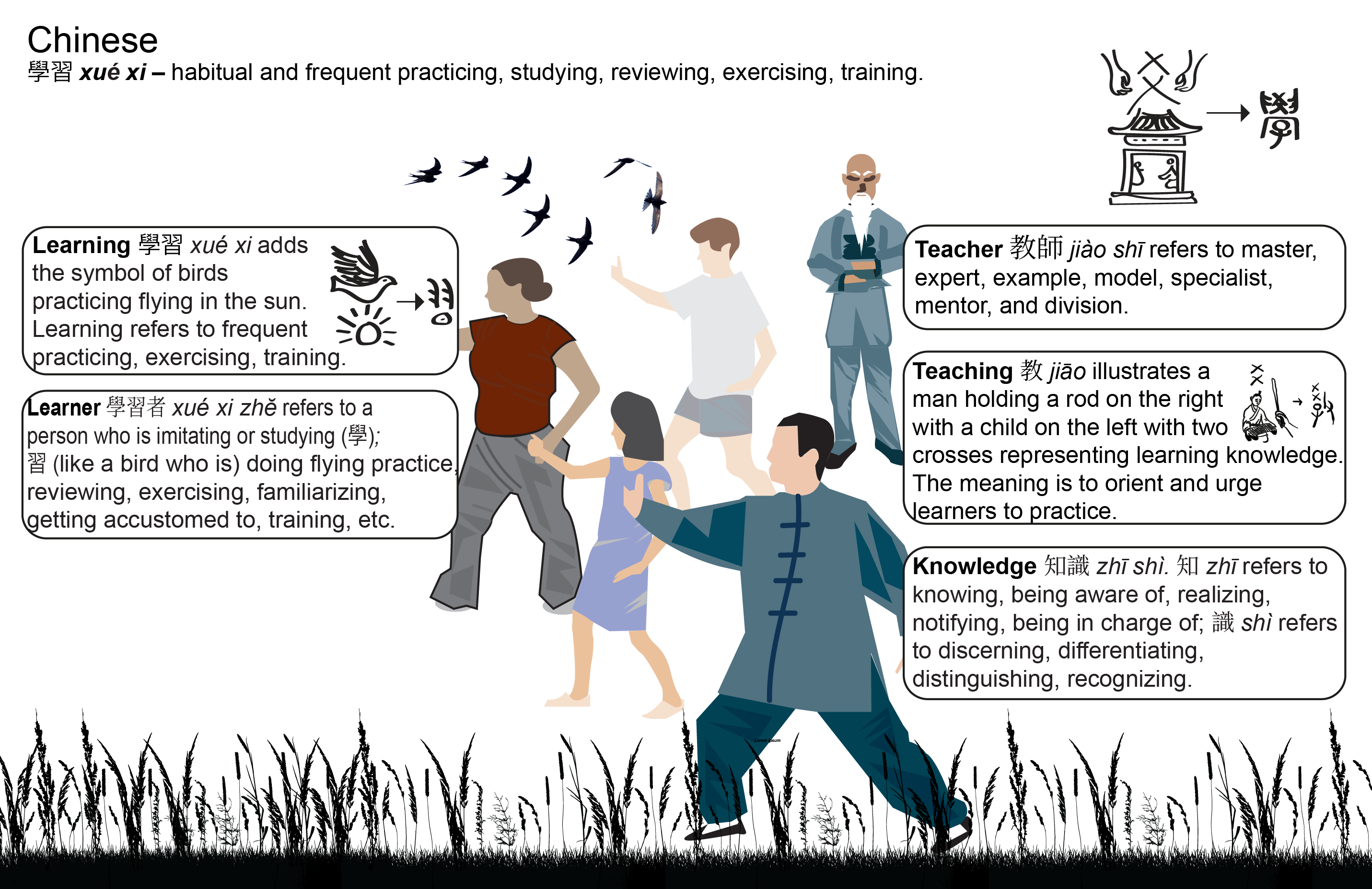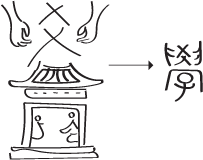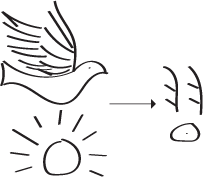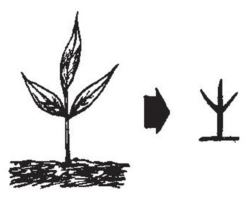Root Metaphor
Composite Visual Metaphor

Etymology
Developed as a pictographic, ideographic, and phono-semantic language, characters in the Chinese language may be considered as a type of logogram with written symbols that represent words rather than sounds. Similar to a picture, each character is worth 1,000 words. This makes translating difficult because several meanings are invoked at once. Please note that traditional Chinese characters are used in this study, as there may be a loss of meaning in the simplified (modern) Chinese characters currently used in many parts of the world.
| Learn: 學 xué. The origins of 學 xué are derived from an image (see the image on the right) that shows two hands setting sticks or straws, which may represent counting (numeracy) and learning knowledge (literacy). The two crosses (like two “x”) are a symbol used in 八卦 bā guà (a term employed in Daoist cosmology), which represents “knowledge” (numeracy and literacy). As a verb, 學 xué refers to studying, learning, imitating, mimicking, speaking, etc.; as a noun, 學 xué is used to combine with other Chinese characters to make nouns such as 學校 (school), 小學 (elementary school), 中學 (middle school), 大學 (university), 學院 (college); 學生 (student); 學問 (knowledge, abilities; level; knowing; reasoning); 學科(disciplines) or 某一門类系統的知識 (one of the subjects; one of the disciplines), 哲學 (philosophy),數學(mathematics), 物理學 (physics), 化學 (chemistry), 生物學 (biology), 歷史學(history),地理學 (geography), 天文學(astronomy), etc. |  |
| Learning: 學習 xué xi. Although 學 xué is used as a verb by itself, 學習 xué xi are commonly used together in Chinese. The origin of 習 xí as displayed in the image/ideograph of 習 (right) shows two feathers (of a bird) above the sun, which indicates a bird practicing flying during daytime (when the sun is out). Thus, 習 xí as a verb refers to practicing, reviewing, exercising, familiarizing, being used to, getting accustomed to, training; and it as a noun refers to habit, custom, usual practice, etc. |  |
| Student:
學生 xué shēng adds the derivation of an image of a newly growing plant. 生 sheng (verb, noun, adjective, adverb) means raw, unripe, uncooked, crude, give birth to, grow, living, accrue. You need to study first (學); then once you have a good understanding of what the teacher taught you, the student may create something new to contribute in some way (e.g., understanding, an artifact, a product, etc.) (生). Like a plant, each student is unique and so is their contribution. The student is one type of learner with a teacher (while other types of learners may not have a teacher). |

|
| Learner: 學習者 xué xí zhě refers to a person (者) who is imitating or studying (學); 習 (like a bird who is) doing flying practice, reviewing, exercising, familiarizing, being used to, getting accustomed to, training, etc. | |
| Teaching: 教 jiāo as displayed in the image (right) illustrates a man holding a rod on the right and a child on the left with two crosses above his head representing learning counting (numeracy) and knowledge (literacy). The meaning is to orient and urge learners to practice. |  |
| Teacher: 教師 jiào shī refers to the master of teaching. Building on the symbol of teaching, the symbol 師 shī means master, expert, example, model, specialist, mentor, etc. | |
| Knowledge: 學問 xué wèn – 問 wèn as a verb or noun means asking, which adds the derivation of an image of “a mouth at the opening door”. This image infers that knowledge is the responsibility of the learner. You need to ask to understand. 學問 xué wèn refers to a higher level of knowledge. |  |
| Knowledge: 知識 zhī shì – 知 zhī refers to knowing, understanding; 識 shì refers to discerning, differentiating, distinguishing, recognizing, appreciating, etc. | |
| Education: 教育 jiào yù as a noun refers to a process of cultivation, teaching, instructing, inculcating, indoctrinating, inspiring, enlightening, etc... It adds the derivation of an image of a mother giving birth to the symbol of teaching. 育yu (verb) refers to giving birth to, fostering, raising, rearing, bringing up, educating, etc. |  |
Common metaphoric phrases
Common phrases about learning
- Isn’t it a pleasure to have timely and frequent review (or practice) after learning? 學而時習之,不亦說乎?(Confucius 孔子, 551-479 B.C.E.)
- (A person should feel) insatiable in learning. 學而不厭。 (Confucius 孔子,551-479 B.C.E.)
- Learning without thinking leads to confusion (or gets lost); thinking without learning ends in danger (or gets nothing). 學而不思則罔; 思而不學則殆。 (Confucius 孔子,551-479 B.C.E.)
- We discover our ignorance after learning (We know that we have known not enough after learning) 學然后知不足。(Xue Ji《學記》, the oldest paper specifically discussing about education, teaching, and learning in the world, written in the late Warring States Period in 476-221 B.C.E.)。
- Learn for application (We should apply what we learned rather than lingering on what is learned). 學以致用。
- There is no ending in learning (Learning is endless). 學无止境。(Liu Kai劉開, 1784-1824)。
- Study diligently and ask frequently if you do not understand it. 勤學好問。(Zhu Xi朱熹, 1130-1200)。
- A person is never too old to learn. (Live until old while study until old) 活到老,學到老。(Lao She 老舍, 1899-1966)。
- Learning by self and becoming a useful/talented person/professional. 自學成才。
- Han Dan studied how to walk gracefully. 邯鄲學步。This is a famous Daoist story about a person who learned (imitated) other’s customs while forgetting his own.。(Zhuang Zi 莊子, 369-286 B.C.E.)。
- The master leads you in the door and the practice (e.g., a monk’s daily practice) is up to yourself (it depends on your own efforts). 師傅領進門, 修行在个人。
- He who devotes himself to learning from day to day to increase (his knowledge); he who devotes himself to the Dao from day to day to dimmish (his doing). He diminishes it again and again till he arrives at doing nothing; then, there is nothing he does not do. [The student of knowledge (aims at) learning day by day; the student of Dao (aims at) losing day by day. By continual losing, one reaches doing nothing. He who conquers the world does so by doing nothing.] 為學日益,為道日損。損之又損,以至於無為。無為而無不為。(Lao Zi 老子, 571-471? B.C.E.).
Common phrases about teaching
- Among any three people walking, there must be at least one who can teach me. Choose the good ones (e.g., behaviour, morale) and follow, and change what is bad (be humble and learn from both good and bad). 三人行,必有我師焉。擇其善者而從之,其不善者而改之。(Confucius 孔子, 551-479 B.C.E.)。
- Teach/educate regardless of students’ social classes (Everyone in all social classes should be educated.) 有教無類 (Confucius 孔子, 551-479 B.C.E.)。Note: Confucius is the first person who started mass education!
- Teaching and learning enhance each other. 教學相長 。(Lin Ji, Xue Ji《禮記·學記》)
- Teaching with words while demonstrating with actions (to model or show what to teach). 言傳身教。(Fan Ye范曄, 398-445)。
- Demonstrating with actions is more important than teaching with words. 身教重於言教。
- (Teachers should feel) tireless in teaching.誨人不倦。(Confucius 孔子, 551-479 B.C.E.。
- After teaching, you know what puzzles you or what you are not good. 教然後知困。(Lin Ji, Xue Ji《禮記·學記》)。
- Teaching/educating students according to their qualities, interests, etc. 因材施教。(Confucius 孔子, 551-479 B.C.E.)。
- When students are close to and have a rapport with their teacher, they believe and learn well what the teacher instructs. “親其師,信其道”。 (Xue Ji《學記》)。
Common phrases about knowledge
- My life (human life) is limited, but knowledge is limitless. Using what is limited to pursue what is limitless can only result in danger(or failure). 吾生也有涯,而知也無涯。以有涯隨無涯,殆已!(Zhuang Zi 莊子, 369-286 B.C.E.)。
- When using what you have learned, you may hate (or regret) the limited knowledge you have. It is never too much if you have extensive knowledge. 書到用時方恨少; 學富五車不為多。
Phrases about knowing
- It is wise to hold what you know and admit what you do not know (Knowing is knowing while unknowing is unknowing. This is wisdom.). 知之為知之,不知為不知,是知也。(Confucius 孔子, 551-479 B.C.E.)。
- Knowing it is not as good as liking it; liking it is not as good as enjoying it. 知之者不如好之者,好之者不如樂之者。( Confucius 孔子, 551-479 B.C.E.)。
- The one knows that he does not know is the best; the one (pretends to) know what he does not know is sick-minded. 知不知,上;不知知,病。(Lao Zi 老子, 571-471? B.C.E.).
- He who knows does not speak; he who speaks does not know. 知者不言,言者不知。(Lao Zi 老子, 571-471? B.C.E.).
Commentary
- Close to the English word learning, the two Chinese characters 學習 xué xí are commonly used together in Chinese. These compound words as a term are traced back to Confucian saying “Isn’t it a pleasure to have a timely and frequent review (or practice) after learning?” 學而時習之,不亦說乎?
- 學 xué was created in the Oracle-Bone Inscription time (over 3,000 years old). It looks like a person is engaging or working on numeracy and literacy while 習 xí indicates practicing, reviewing, exercising, familiarizing, getting accustomed to, training, etc.
- 學 xué refers to attaining (e.g., hearing, seeing, imitating) info including sensory information, knowledge, and thoughts.
- 學 xué can be conducted by self or taught by other people/things while 習 xí focuses on reviewing, practicing, or exercising.
- 學 xué emphasizes the fields of theory or thoughts while 習 xí emphasizes actions and practice.
- 學 xué is an accumulation of knowledge and experiences while 習 xí is the practice or application of knowledge.
- 學 xué is more about knowing while 習 xí is more about doing (acting). Wang Yangming 王陽明 (1472-1529) promoted “the unity of inner knowledge and action” 知行合一 in 1509.
Chinese language 中文 zhōng wén usually refers to hàn yǔ 漢語 (Han language) and hàn zì 漢字 (Han characters). Chinese characters have been considered to be an abstract art (e.g., calligraphy), which is rare among languages around the world. There may be 100,000 hàn zì 漢字 (characters), but there are a few thousand commonly used in daily life. For example, 1,000 Chinese characters covers 92% written materials, 2,000 for 98%. There are 56 official nationalities in China. Han nationality makes up 92% of the total population in mainland China. Hàn yǔ 漢語 (Han language) has standard (普通話 pǔ tōng huà or 國語 guó yǔ) and dialects. With over 6,000 years of history, the Chinese language hàn yǔ 漢語 is one of the oldest languages in the world. It is the only ancient language that has been continuously used for thousands of years and appears to be the only pictographic and ideographic language in the world nowadays. It is one of the six official languages of the United Nations. With over 1.7 billion speakers, Chinese 中文 (zhōng wén) is the world’s most spoken language. As well, the Chinese language has impacted on other languages including English. For instance, the Oxford English Dictionary includes 1,500 words with Chinese elements.
Chinese language (中文 zhōng wén) has greatly influenced surrounding countries (e.g., Korea, Japan, Vietnam, Singapore) and regions (e.g., Hong Kong, Marco, Taiwan). These countries or regions used or still use the Chinese language (e.g., an official language in Singapore, still partially used in Korea and Japan, discontinued in Vietnam) and regions (e.g., fully and officially used in Hong Kong, Marco, and Taiwan). Interestingly, all these eight countries or regions are among the top 10 (mainland China #1) in the recent international education tests (e.g., PISA).
Implicit Spatial Associations
The metaphor of Chinese 學習 xué xi suggests learning by self (e.g., via books, thinking) or from other people or things, and practicing in a room, society, or nature.Bibliography
- Li Leyi 李乐毅 (1992). Tracing the roots of Chinese characters: 500 cases汉字演变五百例子. Beijing Language University Press北京语言学院出版社.
- 百度百科https://baike.baidu.com/
- 查字典https://www.chazidian.com/
- 在线新华字典https://zd.hwxnet.com/
- 在线汉语字典http://xh.5156edu.com/
- 汉语大词典(成语词典)http://www.hydcd.com/cy/
- “国家教育研究院”,National Academy for Education Research (Taiwan), https://dict.idioms.moe.edu.tw/
Peer Reviewed by: Dr. Wenting Wendy Rong
Please cite this article as:
Francis, K., Davis, B., Lu, C. & Lu, O. (2022). "學習Xué Xi" (Chinese) in Metaphors of Learning in Different Languages. https://doi.org/10.11575/8B7N-V637. https://learningmetaphors.com
⇦ Back to Map
⇦ Back to List
